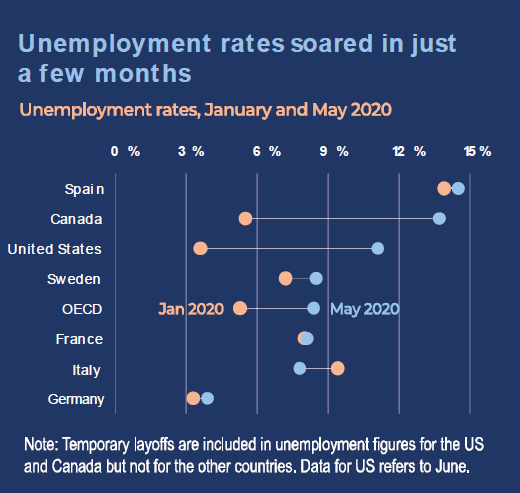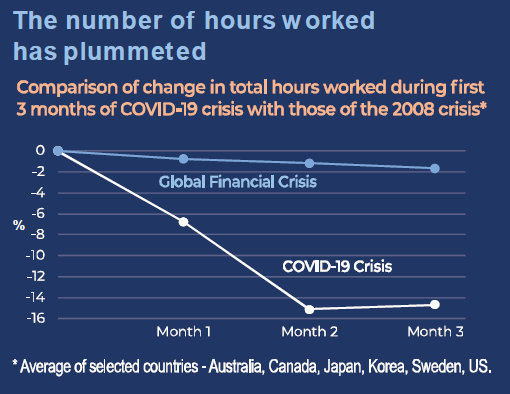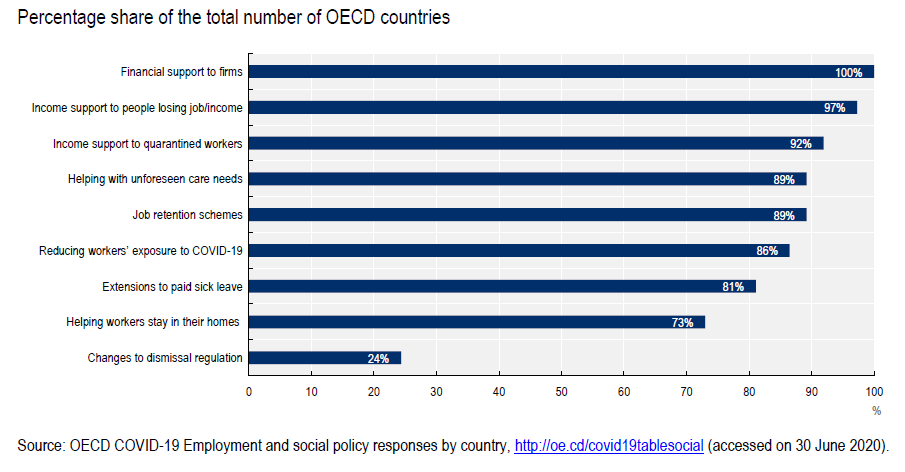Editor's note: COVID-19: Economic Analysis is a series of articles comprising experts' views on developing micro and macroeconomic situations around the globe amid the COVID-19 pandemic.
The COVID-19 crisis will cast a long shadow over global economy and labor market as the pandemic has turned from a public health crisis to a major economic and job crisis that eclipses the Great Depression, according to the latest employment outlook report released by OECD on Tuesday.
New unemployment claims soared in many countries due to a sharp contraction in economic activity amid the COVID-19 crisis. The report, OECD Employment Outlook 2020: Worker Security and the COVID-19 Crisis, predicts a 6-percent annual decline in global GDP for 2020 and a record 9.4-percent plunge in OECD-wide unemployment rate in 2020 and still 7.7 percent in 2021.

Graphic via OECD Employment Outlook 2020
Graphic via OECD Employment Outlook 2020
The report said all countries are facing one of the worst public health and economic crises in a century.
Some experts also say the stagnation situation in the labor market is expected to last for a long time. A paper by professors from the Becker Friedman Institute at the University of Chicago published in June estimates that 32 to 42 percent of COVID-induced layoffs will be permanent.
In the United States, for example, the unemployment rate hit a record 14.7 percent in April, climbing from its 50-year low of 3.5 percent in February, the highest level in this country since 1940.
In Canada, between February and April, the unemployment rate rose to 13 percent from 5.6 percent, up 7.4 percentage points. In May, it continued to rise bit at 13.7 percent.
Data collected by the OECD showed that the cumulative impact of the COVID-19 crisis on employment and hours of work is ten times more than during the global financial crisis.
"In early 2020 the employment rate in the OECD reached a record-high of 68.9 percent, 2.6 percentage points above the previous record just before the global financial and economic crisis of 2007-08," said the report.

Graphic via OECD Employment Outlook 2020
Graphic via OECD Employment Outlook 2020
Different scenarios within regions, among labors
The report also observed different scenarios within countries and regions, which are highly aligned with the severity of COVID-19 outbreaks.
Regions or states with more sizable outbreaks are experiencing more severe economic losses, and more volatilities in the job market. Different sectors also experience varied degree of impacts based on their specialization: some sectors are more exposed to confinement measures or to disruptions in the supply chain, said the report.
From the perspective of employees, it shows more vulnerable workers are bearing the immediate brunt of this crisis.
Already disadvantaged groups of workers often suffer most from economic crises, as they are the first out when the shock hits and last in when the recovery starts, said the report.
Situations differ in terms of different labor groups: higher-earning workers often worked from home, lower-earning workers often had to stop working, due to differences in awareness and access to information as well as structural divides in the access to jobs, according to the report.
For instance, people in higher-income neighborhoods may be more likely to be employed in jobs that can be done at home to weather through the period.
Meanwhile, "frontline workers," including health care workers, cashiers, production and food processing workers, and janitors, are also much more likely to be working in sectors affected by shutdowns, more likely to have suffered job or earnings loss, and also often at a substantial risk of exposing themselves to the virus while working.
In addition, women are playing a key role health care response to the pandemic as they make up two-thirds of the health workforce worldwide, and account for 90 percent of long-term care workers across OECD countries, said the report

New measures taken by OECD countries in response to COVID-19. /Graphic via OECD Employment Outlook 2020
New measures taken by OECD countries in response to COVID-19. /Graphic via OECD Employment Outlook 2020
Policy measures by countries
Countries across the world have rolled out a slew of economic relief packages to secure employment amid the coronavirus hit, including financial support and subsidies for businesses, insurance benefits and job retention schemes.
At the same time, new models of employment were also being tapped as the "self-isolate" period requires a reduction in business activity.
For example, some European countries came up with the "short-time work scheme" to relieve pressure. In the economic crisis of 2008, the "short-term work system" already played an important role, saving more than one million jobs for Germany.
Japan explored the "shared labor" model where employees can be transferred to different work places for a short time.
The OECD also suggested that unemployment benefits are crucial to protect against earnings falls resulting from job losses, and employment protection legislation is key for workers' security amid the crisis.